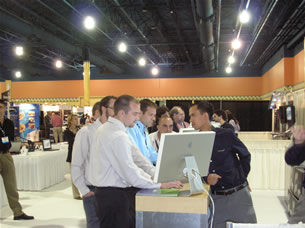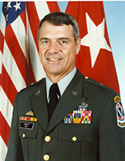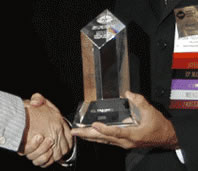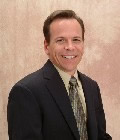RAPID 2008 Conference Report
3D scanning, DDM, medical applications and nanomanufacturing were just some of the topics addressed at the annual conference.
Latest News
June 12, 2008
By Susan Smith
 Photo courtesy of SME |
By its very nature, rapid prototyping challenges its proponents to embrace change.
Change was a primary theme of the RAPID 2008 Conference, entitled “The New Wave of Manufacturing,” held in Lake Buena Vista, FL, at the Disney Coronado Springs Resort, May 20 to 22, 2008.
Keynote: Brigadier General Nick Halley, US Army Ret.
The keynote address was presented by Brigadier General Nick Halley, US Army Ret., who outlined his illustrious career as a recognized expert on leadership, terrorism, change management, and integrity. Moreover, Halley was director and vice president of international electronics firms such as Motorola.
 Halley began his talk by stating that China, population growth, war in Iraq, and cost of oil combine to place the manufacturing industry under great pressure.
Halley began his talk by stating that China, population growth, war in Iraq, and cost of oil combine to place the manufacturing industry under great pressure.
To meet these challenges, Halley stated that as a country, leadership within the industry was of paramount importance. Based on his vast experience as a general, having led “tens of thousands” of soldiers in Desert Storm and Vietnam, Halley has developed 13 leadership principles. One of the primary ones is as follows:
Saying no to the status quo — change is a motivating factor in your life. Many people are going to resist change. Leaders manage change. Halley quoted author Jack Welch, who said that if change outside your organization is greater than the change inside your organization, then you’re not going to survive.
Halley concluded by stating that “Leadership is the key to rapid manufacturing technology success, to individual success, to organizational success,” and charged listeners with figuring out how to apply those principles.
 RTAM Plenary Session Awards
RTAM Plenary Session Awards
Todd Grimm presented the Dick Aubin Award for the paper “Design of Patient Specific Porous Titanium Implants for Craniofacial Applications,” written by Jayanthi Parthasarathy, also presenting author, a dental surgeon pursuing her PhD, and co-authors Binil Starly and Shivakumar Raman. They are using a new process called electronic beam melting.
The RTAM Industry Achievement Award is a global award given to an individual doing research and development implemented for the commercial industry. This year’s award went to Gideon N. Levy, Prof. Dr. Sc. M.Sc. Inspire AG, irpd.
“After-market automotive peripherals,” which included customized airvents and custom door handle, won the Design for DDM Design Competition 2008.
What’s New in RTAM — Technology Updates
Grimm introduced Mat Cappel of Exact Metrology who spoke on the topic, “3D Data Capture – Reverse Engineering.” As chair of the 3D Scanning technology group, Cappel listed what’s new in 3D scanning technology, top collaborations and consolidations and future trends:
What’s new in 3D scanning technology
- Inspectworks for SolidWorks – runs in SolidWorks
- Range7 Minolta – new scanner for this year, unveiled some months ago.
- Faro new Photon scanner – scans about 80 meters, phase based very clean
- API and Brunson have service arms
- Zeiss and Xylon both have CT systems
- Direct Dimensions new Blue light technology
Top collaborations
- SME and CMSC – sharing booth space
- Handiscan and Z Corp – Handiscan working with Z Corp for distribution of their scanners.
- DPI and Faro – now being distributed by Faro
- Surphasor and Trimble (scanner)– German company now teamed with Trimble for distribution of scanners.
Top consolidations
- ATT – Metrology bought Metrologic
- Cognitens scanners purchased by Hexagon
- Metris and Krypton – new K-Scanner
- Berding 3D Scanning and Exact Metrology merged
History
- Metric Vision is gone
- VX scanners are gone
The Big 6
- InnovMetric
- GeoMagic
- RapidForm
- Metris (hardware)
- Hexagon (hardware)
- Faro (hardware)
Cappel predicted that consolidation will continue to happen, and the future is consolidation.
In Universityof Louisville’s Tim Gornet’s keynote on “Materials/Metals/Tooling,” Gornet pointed out that the past year was characterized more by the expanding application of materials in DDM than in the breakthrough of new materials.
Materials implemented over the past year
a) Plastics
Photopolymers
Sintering
Fused deposition modeling
b) Metals
According to Gornet, STL has the largest numbers of materials available of any of process. Clear materials, semi-flexible materials, high strength, high temperature are all photopolymers using thermoset epoxy type chemistry.
3D Systems has a new suite of materials including Accura Xtreme, an ABS like 14-22 percent and Greystone Nanocomposite which possesses significant stiffness and strength that can be used for wind tunnel models.
DSM Somos’ new DMX SL 100 is a high impact resistance material, while their WaterClear Ultra 10122 offers high optical clarity for lenses and clear covers. The company also offers ABS-like materials and NanoTool, which features high stiffness and ability to withstand high temperature.
Huntsman Advanced materials include RenShape SL 5510, a high flexural modulus, high elongation and ABS-like material.
Gornet also mentioned the Objet Connex 500, a machine that lets you use multiple materials in one implementation process.
According to Gornet, the majority of all laser sintering materials available today are polyamide based (nylons 12 and 11).
3D Systems offers:
- DuraForm HST – high strength and temp whisker filled material
- DuraForm EX – high impact strength and high elongation polyamide
EOS offers:
- CarbonMide – a carbon fiber filled material for stiffness and strength (auto and wind tunnel testing)
- A new yet-to-be-released material
- PA 200 FR – fire retardant polyamide
Advanced Laser Materials of Belton, TX offers FR 106, a fire retardant polyamide that passes the Federal Aviation Administration (FAA) 60 second vertical burn test, designed for commercial aircraft applications.
CRP of Modena, Italy offers Windform materials, which are carbon filled, glass filled, aluminum, and neat polyamide materials.
Stratasys appears to lead the way in Fused Deposition Molding (FDM) by recently adding its ABS M30i – medical and food grade (ISO 10993) to their materials database. The company’s materials list also includes polycarbonate and PC/ABS blends.
Metals
Gornet noted there is a lack of knowledge of metals systems and processes, and therefore, there are few metal materials systems available for use. Because of the limitation in their application, he said metals based processes currently offer the best properties as compared to wrought alloys of the same composition.
Some of the processes can allow for gradient materials which are not available any other way.
Most of the direct metals machines have targeted the higher value applications such as aerospace and biomedical. Titanium has been most popular in those market segments, and following it, metal parts, with tooling bringing up the rear.
Most vendors are only looking at a few materials, such as powder based, etc. “As we increase our knowledge of mechanical properties, a lot more people will look at the applications of metals,” said Gornet.
The DMLS system from EOS offers direct metal for steel and lower, in cobalt chromium and titanium.
Arcam offers Electron Beam Melting, titanium, cobalt chromium and the H13 tool for medical and aerospace.
3D systems marketing MCP-Hek Realizer offers stainless steel, titanium, cobalt chromium, with proprietary powders not required.
What puts the industry into perspective were some case studies of companies using some of cutting edge RP&M technologies.
DDM
Jeff DeGrange from The Boeing Company, said they are continuing to advance DDM for production of competitive parts. They use the Fused Deposition Modeling 900MC System from Stratasys.
The company was challenged with the need to do larger builds in order to eliminate the amount of assembly and post production processing. The 900MC System has a “much larger envelope, user friendliness, improved throughput and improved performance,” according to DeGrange.
Other features include 10x greater than existing MC, Accuracy and repeatability, Ball screw gantry, Industrial thermoplastics, Designed with purpose of DDM, and Industrial Machine tool approach.
Productivity improvement in EOS’ EOSINT P730 include larger frame systems, improved coding and thermal coding systems.
The bottom line for the production environment is high yield and the lowest amount of downtime, so process control becomes an important aspect of the use of materials and new processes.
DeGrange said they want to manage the information to achieve operational efficiencies, upstream in the engineering environment and efficiencies in your actual build. “In order to get repeatability on a consistent basis it’s essential to push into the production environment.”
In addition, the goal of Boeing is to have machines at multiple stages to know where you are in your manufacturing process utilizing a “manufacturing execution system.”
Another RP technology used at Boeing is the 3D Systems selective laser sintering heater design. “We have been using this process within Boeing for 10 years, and want to improve consistency of systems,” The idea is to build a multi-zone heater to improve consistency of temperature. “We can actually control heat, and drop in a replacement for the current radiant heater, with variation of only 3C,” said DeGrange.
Medical Applications
Dr. Stephen M. Schmitt, DDS, MS, Medical Applications, Dental Implant Technologies, Inc., pointed out that more companies are buying other companies, and integrating to achieve a specific business process or product.
He gave the example of doctors who need an intuitive interface, who “won’t sit down to learn Pro/E,” but they still want to make their own part which they can’t find in the marketplace.
Schmitt said that titanium is magic metal in medicine, and said there are several systems that manufacture high quality titanium parts.
With Cone Beam CT, many data acquisition procedures can be simplified. For example, it’s relatively inexpensive to do a scan of one rotation of a person’s head, and “anyone can do it.”
The Itero Intra-oral Scanner is a big scanner for doing dental castings, which have traditionally been done by hand. 3M and other companies are investing on this digital transformation.
The 3M ESPE Dental Scanner is designed for design through to manufacture in one process.
With the SensAble Dental Lab System, a surgeon can sit down with CATscan data and within five minutes can interact with the data.
Materialise’ SimPlant, specific for surgeons, may go from a software to a server based process, according to Schmitt. Their Rapid Shell Modeling, a process to create ear molds, is a more customized business case developed system. Another development in
NeXsmile from Voxelogix is a unified system that allows a patient to go to the imaging center with a plastic device in their mouth to decide upon what kind of implants they would like.
These types of systems allow physicians and dentists to custom design before doing surgery, without having to know complicated software.
Schmitt said that tissue printing and regenerative processes hold great potential for the medical community but are not commercially viable yet. If you can print out a 3D shape for cells to grow into, he said, over time you can create structure for the cells to grow on, whether liver, kidney, bladder or other organ.
 Nanomanufacturing
Nanomanufacturing
Speaker Tihamer Toth-Fejel of General Dynamics listed application areas for nanomanufacturing, which included: filters, electronics, fuel cells, and killer apps such as Nanofactory, Programmable matter, and Medicine and enhancement.
Toth-Fejel introduced what is known as the “nanocube pore double filter.” He says, “With a machine like this you could create a kidney dialysis machine from your nanofactory.”
With Proton Exchange Memory (PEM) fuel cells the following killer applications are possible:
Killer App#1 Printing appliance would allow you to build a large variety of products with precision, use electron microscopy as a tool to put these things together. Cybex able to use thousands of these simultaneously to build models.
Killer App#2 Programmable Matter in the form of tiny “botlets” that can bond and can form into whatever you want, for example, a robot that is already healing itself (Terminator 2 stuff ). DARPA is already working on this.
Killer App#3 Human medicine and enhancement – “We’re going to need to access all the different atoms and molecules in our bodies,” said Toth-Fejel. “We could replace over 10% of our bloodstream with “respirocites” which would allow you to hold your breath for over 24 hours. If your heart stopped, you can call the hospital and tell them you’ll be there, you would have time.” NASA and DARPA are looking at these possibilities.
Paul Rothemund of Caltech is working with DNA origami, or structural DNA. Rothemund said that molecule recognition can build nanostructures like a recipe. You will be able to order certain types of DNA and form it into structures.
 Todd Grimm |
Kick-Off Keynote: Todd Grimm, T.A. Grimm & Associates
Leading industry advisor, Todd Grimm, T.A. Grimm & Associates, talked about opening your mind to change. He talked about the hype cycle coined by Gartner, a graphic representation of the maturity, adoption and business application of specific technologies.
What this involves is the over-enthusiasm or “hype” and ensuing disappointment that follows with the introduction and adoption of new technologies. Hype cycles show when a technology may be likely to move beyond the hype and decline to become practically adopted and useful. There is generally a lull in the storm, said Grimm, then you can climb out with evolutionary progress and go into a growth cycle.
To make necessary changes, Grimm advises that we need to eradicate myths, develop standards, and advance the arts/sciences.
Grimm said that we need to disseminate information from sciences to the masses. It is easy to ignore and discount some of the new technologies because they’re not there yet. But ignorance can cost you lost opportunities.
Most importantly, the biggest change is not technological, “it’s people and resistance to change,” said Grimm.
He counseled the we need to be open to what things we can do, and minimize resistance to change. Also, make realistic first attempts, avoid mission critical applications of new technology.
“Don’t take your flagship product and use DDM for the first time, do something easy,” Grimm said. By seeking low risk alternatives that already exist. If it doesn’t work then you’re only out a few bucks and you’ve learned something.
Grimm said he can’t tell how big the “new wave of manufacturing” will be, as it will also be different industry by industry. The future requires you to be adaptable, flexible and willing to secure information on your own.
Regarding the conference, Grimm said, “I hope you can take away something that makes you more receptive to what DDM and 3D scanning can do.”
RAPID 2008
Lake Buena Vista,FL
Susan Smith is a contributing editor for Desktop Engineering magazine.
Subscribe to our FREE magazine, FREE email newsletters or both!
Latest News
About the Author
DE’s editors contribute news and new product announcements to Digital Engineering.
Press releases may be sent to them via [email protected].






